
https://www.youtube.com/watch?v=Z4VjfSWZJQs
7 Common Pregnancy Mistakes That Increase Risk of Postnatal Complications

when you're pregnant , even simple activities like getting into and out of bed becomes something you really need to think about .
because when you're pregnant , even easy movements like this can place additional pressure on your weakened abdominals and pelvic floor muscles .
you can think of these muscles as an elastic band that acts like a corset wrapping from your ribs to the back of your pelvis .
they're essential for stabilizing your core , supporting your internal organs and even assisting in the birthing process .
now before you were pregnant this elastic band was tight , but during your pregnancy this band starts to stretch as it accommodates the increasing size and weight of your growing baby .
as these muscles stretch they naturally get a bit weaker and when this happens even simple movements can place extra pressure on that already stretched out band .
this can lead to post-birth complications like prolapse , abdominal separation , urinary incontinence , or even persistent back and pelvic pain .

and unfortunately , it's not just how you get into and out of bed which causes additional pressure on these muscles .
everyday actions like lifting your child , carrying groceries or bending to pick something up as well as how you stand and sit can all amplify these risks if you use the wrong technique .
now exercises and movements like these aren't my area of expertise .
this is something a physiotherapist or physical therapist is much more qualified to cover .
but i think this is really important information that i want to share with you .
so i brought in physical therapist megan stevenson to guide you through a series of essential changes to make to your daily activities throughout your pregnancy to help minimise the risk and severity of these issues .
over to megan , starting with how to get into and out of bed before pregnancy .
typically when you're not pregnant we all seem to leap into bed .
so what that looks like is we sit on the edge of the bed , swing our legs in and then lay back down .
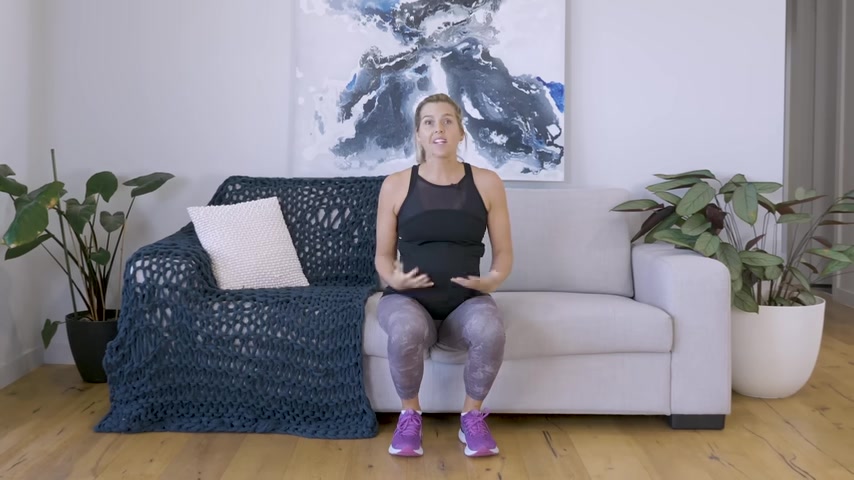
to get out we do the opposite which is a crunch style maneuver , swinging legs over and then sitting on the edge .
as your pregnancy progresses , it gets harder and harder to use your abdominal muscles correctly as the growing weight and load of the uterus puts extra pressure within your abdominal wall .
so that you're not adding extra load or tension through the abdominal wall and pelvic floor getting in and out of bed a simple thing you can do is learn how to log roll so you sit on the edge of the bed make sure you're sitting back so that the bed's behind the knees you want to drop down onto the elbow as your legs swing up together and then gently rolling onto your back .
to get out of bed , it's the opposite .
so you want to roll onto your side as the legs swing off , you press up through both hands , making sure that your shoulders and pelvis stay in alignment .


the next area to pay attention to is how you sit .
adopting a proper sitting posture during pregnancy can greatly influence your overall comfort .
however , when we're pregnant , we often default to one of two postures , both of which can cause discomfort .
the first position that pregnant women seem to adopt is being perched on the edge of the seat .
what this does is help create space for the belly , however it does encourage that increasing curve in the lower back .
what this does is increase the tension through the abdominal wall and the pelvic floor .
this can also put a lot of pressure through the front of the pelvis where a lot of pregnant women experience pain as their pregnancy progresses .
the second position is slumping in the chair .
so what happens is there isn't enough support within the chair to support the lower back which causes the pelvis to rock backwards into a posterior tilt .
by tilting the pelvis backwards , this can place extra pressure through the abdominal wall and the pelvic floor .
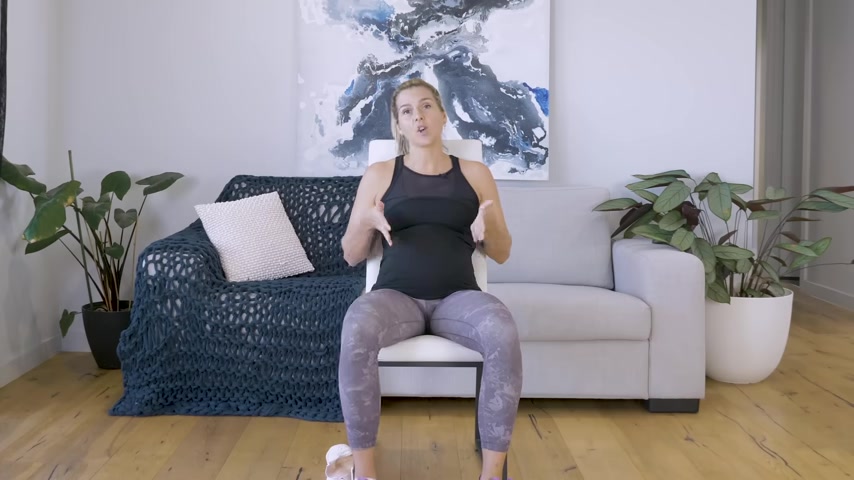
it also can create pain within the lower back as it's in that curved position .
this position can also impact the baby's position as it goes head down into the birth canal to prepare for labour .
during pregnancy , the easiest way to make sure that you have good posture in sitting is to make sure that you sit back in the chair , that your hips are slightly higher than your knees .
you can have something like a towel rolled up to place behind the lower back to protect the curve .
and then if you still find that you're not quite sitting in the right spot , that your pelvis is still rocking forward or rocking backwards , place your hand underneath and separate your cheeks and it just helps you sit right on top of those sit bones , making sure that there's length through the crown of the head and you're nice and open through the collarbones .
while we're on the topic of posture , another posture that changes significantly during pregnancy and requires some tweaking is your standing posture .
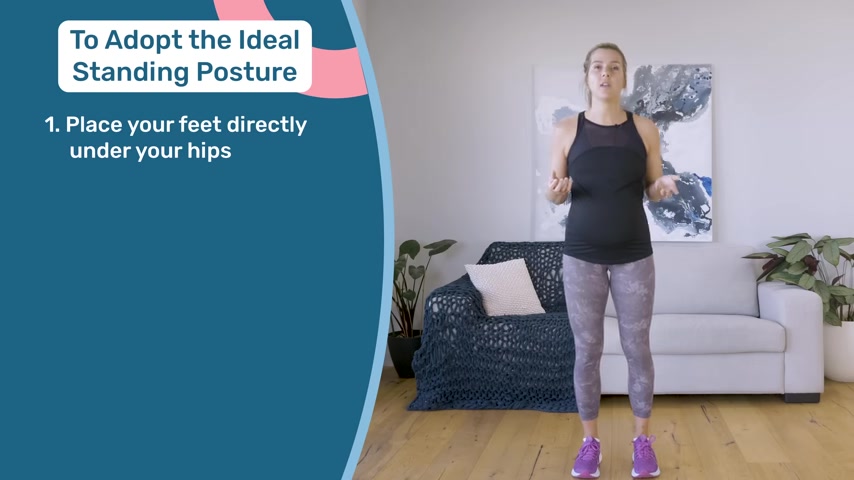
typically during pregnancy your posture can shift in one of two directions .
first one is you can lead with your belly rocking your pelvis forward .
the second being you can rock the pelvis backwards tucking your tailbone under .
both of these positions add additional load and tension through the abdominal wall and pelvic floor muscles .
to avoid this additional load it's important you learn how to stand with your pelvis in a neutral position .
this can be a little tricky to find so i'm going to step you through how to do it .
firstly you want to make sure that your feet are directly under your hips and you want to unlock your knees .
from there you want to rock the pelvis backwards and forwards and you will feel these two extreme movements .
you want to stop in the middle .
this is your neutral pelvic alignment .
from there you want to make sure that your ribs are stacked over your hips , shoulders melting down the spine , and nice and long through the crown of the head .


now let's cover the small tweaks you can make during your pregnancy when lifting objects from toys to heavier things like groceries .
it all starts with the rhythm of your breath .
when picking up a load for example say your toddler or some groceries it's really important that you exhale when you exert .
when you exhale what happens is that that exhale breath helps the pelvic floor and your lower abdominals , your transverse abdominis , cope with that increase in pressure that the load creates within your abdominal wall .
so let's go through how you would pick up some groceries .
so first thing you want to do is split your stance , maintain a nice neutral spine as you inhale and bend at the knees , then exhale , come up into standing , maintaining your neutral spine .
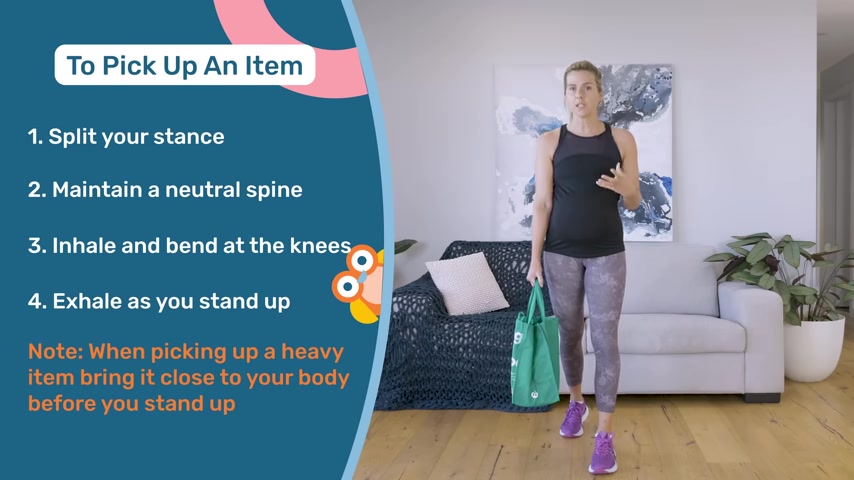
if the load is quite heavy you may find that you have to go lower bring the load towards your center as close to your body as you can and again exhaling to come back up into standing .
to put the load down , same thing in that you want to have your split stance , maintain your neutral spine , and then inhale down , exhale back up .
now if this isn't your first child , you might also need to lift a toddler during your pregnancy and this type of lift comes with additional challenges that you need to cater for .
as usually when you go to pick up your toddler , you do it the quickest way possible .
which is to come down , bend only at the hips , reach forward and pull from the ground and come up into standing .
so as you do that , what happens is there's a lot of pressure going down through the abdominal wall and usually at the belly button , which is the most weakest point .
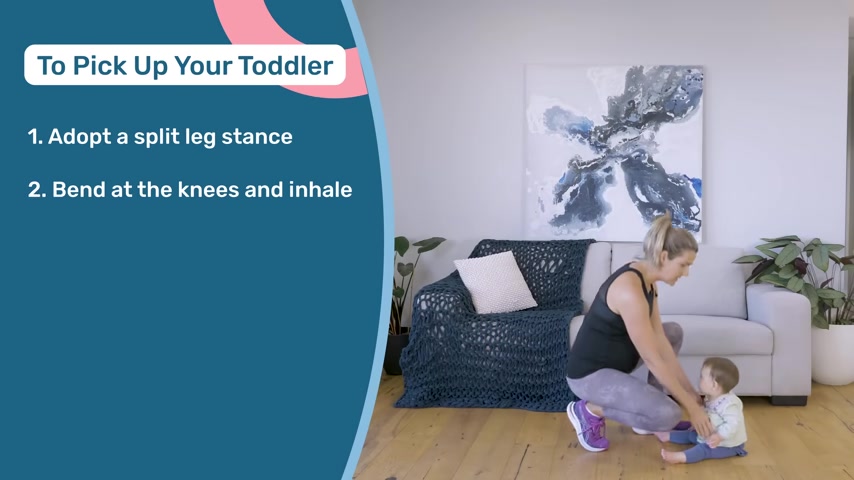
so to pick up your baby correctly or your toddler , similar to what we did with the groceries in that you want to go in with a split stance , bend at the knees , inhale down , bring the baby in and then exhale standing up nice and tall .
and then to put them back down on the ground , it's the reverse .
so just keeping the split leg stance coming down and you may exhale on the way down , place the baby down on the floor , again exhaling to come back up nice and tall .
during pregnancy , aside from lifting your toddler , the way you carry them throughout the day can also impact your posture and overall comfort .
typically when holding a toddler you tend to hold them on your hip which makes the weight shift to one side of the body pulling uneven through the abdominal wall .
this could increase the risk and the severity of your abdominal muscles separating .

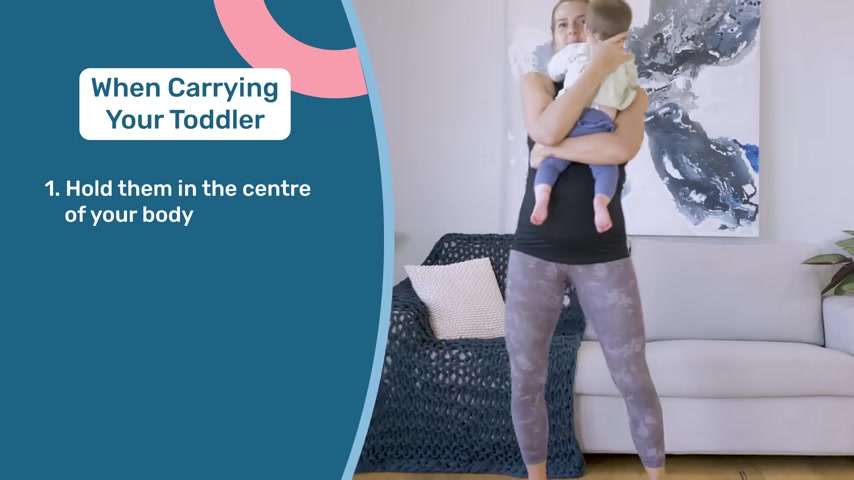
to minimize this risk you want to hold your toddler in the center of your body .
this will encourage even weight bearing through both legs which will make sure the load is going evenly through the abdominal wall and the pelvic floor .
another thing that can happen is the pelvis can tilt backwards which creates this locking of the knees and an increasing pressure within that abdominal wall .
so you want to still maintain a neutral spine while you're holding the toddler and this may mean that you have to rock your pelvis backwards and forwards to find that center of gravity .
in addition to carrying your toddler you may also find yourself pushing them around in a pram and this can put additional stress on your abdominals and pelvic floor muscles so it's important to be mindful of how you push it to protect those muscles and you can do this by making two simple adjustments .
the first thing you need to do is adjust the handlebars on the pram .
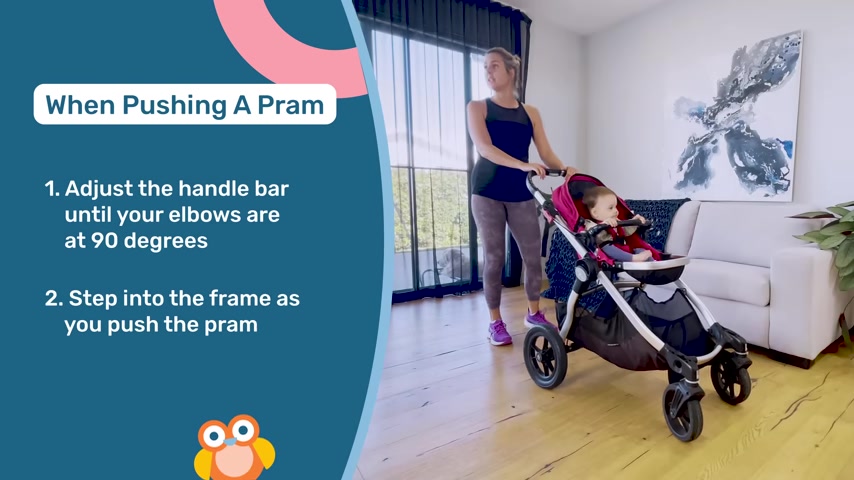
so you want to make sure that your elbows are bent at a 90 degree angle and this will just ensure that you're pushing the load of the pram and the baby with your core muscles and leg muscles rather than your upper body .
the second thing you need to do is make sure that you are stepping into the frame as you are pushing the pram .
what this will do again is ensure that you're using your core and your legs to push the pram rather than the upper body .
if you don't , what tends to happen is the pram will get too far in front and what this will do is just increase that tension within the abdominal wall and thus your pelvic floor .
modifying the way you do things during pregnancy is really important for all the reasons i mentioned earlier in the video , but another really effective way to protect your body and reduce the risk of post-birth complications is through exercise .
regular exercise can prepare your body for the demands of childbirth and also help with your postpartum recovery .

it can help alleviate back pain and pelvic pain , strengthen your muscles and joints to support the added weight of pregnancy , enhance your overall fitness , prevent excessive weight gain , and even reduce the risk of certain pregnancy complications as well as provide lots of benefits to your mental health .
so i'm really excited to share that we're launching a brand new youtube channel here at brightest beginning that focuses on prenatal exercise and protecting and taking care of your body during pregnancy .
our goal is to make the best evidence-based information and resources available to as many parents as possible in order to help create the best possible outcomes for those parents and their children .
which is why megan , a highly experienced physiotherapist or physical therapist for the americans in the audience and pilates instructor is going to be hosting this new channel .
click the link above to go and check it out and hopefully subscribe if you're interested .
i'll also link to it in the description as well .


you'll find a mix of videos containing advice like this one plus a range of different exercise programs and pilates routines .
one of the first videos we've released is a core workout that's suitable for every trimester .
keeping your core strong throughout your pregnancy is extremely important and it helps with so many things including helping to prevent back pain , aiding in the delivery process and it can also help improve recovery post birth .
click here to watch it and learn how to keep your core nice and strong using movements that are safe to do throughout your entire pregnancy .
Are you looking for a way to reach a wider audience and get more views on your videos?
Our innovative video to text transcribing service can help you do just that.
We provide accurate transcriptions of your videos along with visual content that will help you attract new viewers and keep them engaged. Plus, our data analytics and ad campaign tools can help you monetize your content and maximize your revenue.
Let's partner up and take your video content to the next level!
Contact us today to learn more.